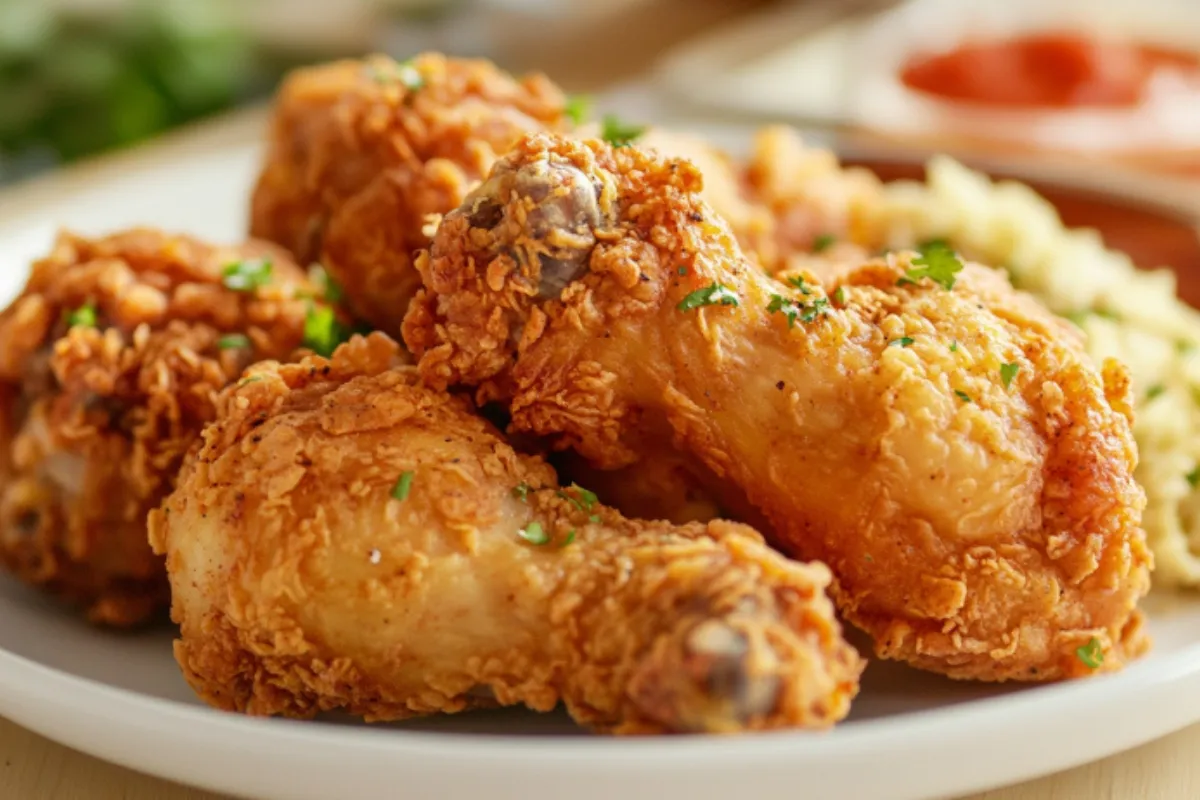Making fried chicken at home is one of the most satisfying things you can do in the kitchen. There’s something special about making fried chicken from scratch, where the crispy, golden crust meets tender, juicy meat. Whether you’re a seasoned cook or a beginner, making fried chicken is an easy and rewarding experience. In this article, we’ll walk you through the key steps and tips for making fried chicken that’s perfectly crispy and delicious every time. Let’s dive into how you can master the art of making fried chicken right in your own kitchen!
Why Fried Chicken Is a Popular Dish
When you think about comfort food, making fried chicken probably comes to mind. There’s a reason why this dish has been so beloved for generations. From family dinners to street food stalls, fried chicken is enjoyed all around the world. The appeal of making fried chicken comes from the way the crunchy, crispy exterior contrasts with the juicy, tender interior. Whether served with a side of mashed potatoes or enjoyed on its own, fried chicken has a special place in the hearts of many.
The Appeal of Crispy, Golden Fried Chicken
The allure of making fried chicken lies not only in the taste but also in the texture. Achieving that perfect crispy golden crust is key to making fried chicken irresistible. It’s all about the combination of hot oil and well-seasoned batter, which creates that satisfying crunch when you bite into it. Plus, the flavor is unbeatable—rich and savory with just the right amount of seasoning. This is why people crave making fried chicken for both special occasions and everyday meals.
History and Cultural Significance of Fried Chicken
The history of making fried chicken dates back centuries, with roots in Southern U.S. cuisine and other global traditions. African, Scottish, and French influences merged in the American South, shaping the unique techniques and recipes we use today. In many cultures, making fried chicken is a celebratory act, often shared during family gatherings or special events. It’s a dish passed down through generations, evolving with time but staying true to its rich cultural significance.
Regional Variations in Fried Chicken Recipes
While the basics of making fried chicken remain the same, regional variations give the dish its diversity and charm. In the South, making fried chicken typically involves a buttermilk soak, resulting in a tender, juicy interior and a crisp exterior. On the other hand, some regions prefer a spicier batter or include different herbs and spices for a unique twist. From Nashville hot chicken to Korean fried chicken, making fried chicken allows for endless creativity and customization.
Essential Ingredients for Fried Chicken
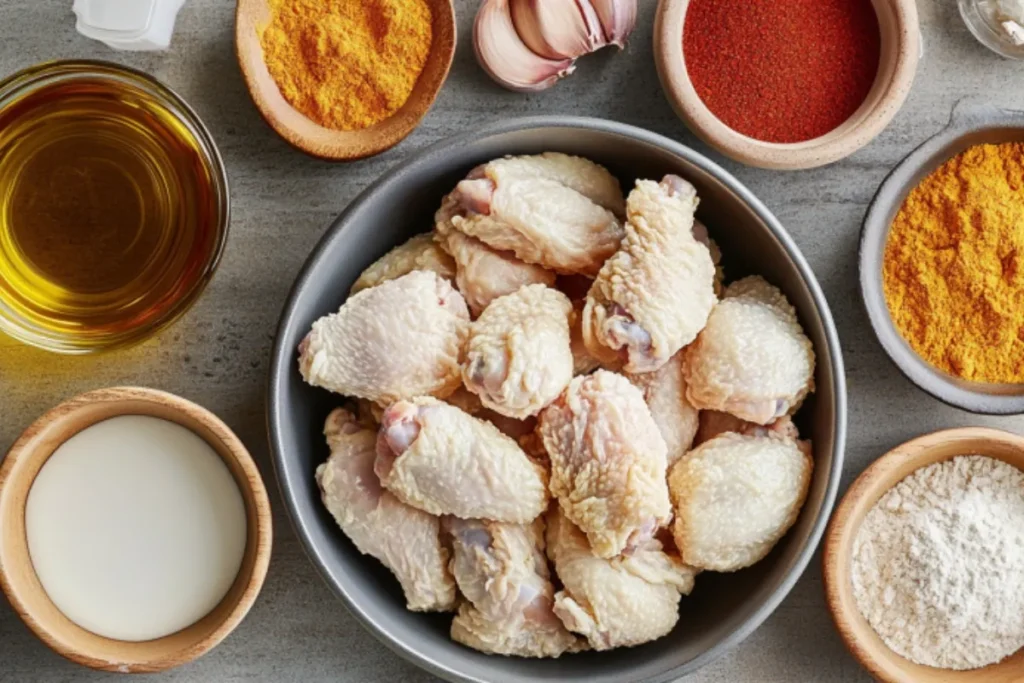
If you’re thinking about making fried chicken at home, it’s important to know the essential ingredients that will give you that crispy, flavorful result. While some may argue about the secret to the perfect fried chicken, the basic ingredients are simple and easy to get your hands on. Let’s break it down:
1. Chicken – The most obvious ingredient, right? But choosing the right type of chicken can make all the difference in your final dish. You can use whole chickens, chicken breasts, thighs, or wings—whatever your heart desires. While wings are always a fan favorite for parties, thighs and breasts tend to offer a juicier, meatier bite.
2. Flour – You’ll need flour to coat the chicken. But it’s not just any flour. Many recipes call for all-purpose flour because it’s versatile and gives a nice crispy texture. However, some people like to use a blend of flour with cornmeal, which adds more crunch to the crust.
3. Seasonings and Spices – The magic happens with the seasonings. Classic fried chicken usually features a blend of salt, pepper, paprika, garlic powder, and cayenne pepper for some heat. However, the fun part of making fried chicken is the variety of seasonings you can experiment with. Some people like to add thyme, rosemary, or even cinnamon for a unique flavor profile.
4. Buttermilk or Marinade – A marinade or soak is another key ingredient. Soaking the chicken in buttermilk is a common practice, as it tenderizes the meat and adds a little tanginess. Some recipes also use a combination of hot sauce or pickling brine to give the chicken an extra layer of flavor before it hits the fryer.
5. Oil – The oil is the unsung hero in your fried chicken journey. The right oil (like vegetable oil, peanut oil, or sunflower oil) is essential because it helps create that crispy exterior without overpowering the flavor of the chicken. You want an oil with a high smoke point so it can withstand the high temperatures needed for frying.
What You Need to Make Fried Chicken
To start, you’ll need a few basic ingredients when making fried chicken:
1. A Cast-Iron Skillet or Deep Fryer – While a deep fryer is convenient, a cast-iron skillet is traditionally used in Southern-style fried chicken. The heavy material distributes heat evenly, ensuring the chicken cooks at the right temperature, giving you the perfect crust. If you’re using a deep fryer, just make sure you keep an eye on the oil temperature.
2. Thermometer – You’ll want to measure the oil’s temperature to avoid undercooking or burning your chicken. A kitchen thermometer is a must-have to keep things at the right heat, usually around 350°F (175°C).
3. A Cooling Rack – After frying your chicken, you’ll need a place to let it rest and cool. A cooling rack allows air to circulate around the chicken, preventing it from becoming soggy while keeping the crispy texture intact.
4. Tongs or a Spider Spoon – To safely handle your chicken while it’s frying, you’ll need tongs or a spider spoon to lower the chicken into the hot oil and remove it when it’s done.
Chicken Selection (Whole, Cut, or Pieces)
When making fried chicken, you can use whole chicken, but most people prefer to work with cut pieces like wings, thighs, or drumsticks. These pieces fry faster and are easier to handle, especially for beginners. The choice between whole chicken or pieces comes down to your personal preference and the amount of time you have.
Seasonings and Marinades for Flavor
The seasoning and marinade are where you can really get creative with your fried chicken. While some prefer to keep it simple with just salt and pepper, others like to add more complex flavors through spices or marinades. Here’s a closer look:
Buttermilk Marinade – Soaking your chicken in buttermilk for several hours (or even overnight) is a classic method. The lactic acid in buttermilk breaks down the chicken’s proteins, making it tender. Plus, it adds a subtle tang that pairs perfectly with the crispy coating.
Hot Sauce – For a kick of spice, many people like to add hot sauce to their marinade. Whether it’s Frank’s RedHot, sriracha, or another brand, the hot sauce will infuse the chicken with flavor before it hits the frying oil.
Herbs and Spices – Depending on the flavor profile you’re going for, you can add various herbs and spices to your seasoning blend. Paprika, garlic powder, onion powder, and cayenne pepper are standard, but try mixing in some thyme, oregano, or even some curry powder for an interesting twist!
Flour vs. Other Breading Options
When it comes to making fried chicken, the breading is just as important as the seasoning. While flour is the most common breading ingredient, there are alternatives you can use to get that perfect crispy coating.
Importance of Seasoning the Coating
You can’t just rely on the chicken itself for flavor—making fried chicken requires seasoning the breading as well. Flour, cornmeal, or even crushed crackers can serve as the base for your coating. Don’t forget to add salt, pepper, and other spices to the breading so that every bite is packed with flavor.
How to Create a Crunchy Crust
The key to a crispy, crunchy crust when making fried chicken is in the frying technique. The breading needs to be hot enough to form a crispy exterior while keeping the meat juicy inside. Double-dipping the chicken in flour and then dipping it in a buttermilk or egg wash before coating it again can give your chicken a double layer of crunch.
Tips and Tricks for Perfect Fried Chicken
Now that we’ve covered the essentials and step-by-step frying techniques, let’s dive into some tips and tricks to help you perfect your fried chicken. With a few simple adjustments, you can level up your fried chicken game and achieve that crispy, juicy masterpiece everyone loves.
If you’re a fan of crispy, golden chicken, you might also enjoy this Chicken Cutlets Recipe Guide, which offers an alternative method for preparing tender chicken with a delicious, crunchy crust.
What Is the Trick to Frying Chicken?
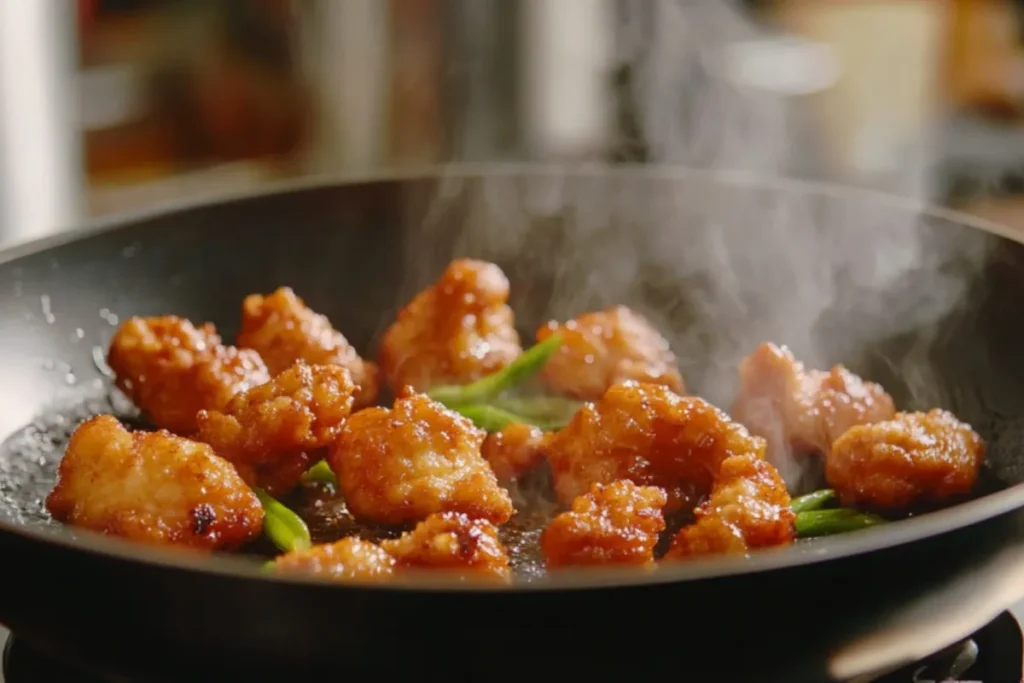
Frying chicken seems simple, but there are a few tricks that can take your fried chicken from “meh” to wow. The key trick? Consistency—both in seasoning and frying technique. Here’s the breakdown:
1. Season Your Chicken Generously
Don’t be shy when it comes to seasoning your chicken. Season not just the flour, but also the chicken itself. Salt and pepper are the basics, but think about adding a bit of garlic powder, onion powder, paprika, or even a touch of cayenne for that kick. Remember, seasoning helps enhance the natural flavor of the chicken!
2. Use the Right Oil
Choosing the right oil is essential for achieving the perfect crispy texture. As mentioned earlier, oils with a high smoke point, like peanut or vegetable oil, are the best for frying chicken. This ensures the oil doesn’t burn and that the chicken cooks evenly. Don’t skimp on the amount of oil—your chicken needs to be submerged enough for even frying.
3. Don’t Overcrowd the Pan
When you overcrowd the frying pan, the temperature of the oil can drop too much, leading to greasy, soggy chicken. To avoid this, fry your chicken in batches. If you’re cooking a lot of chicken, it’s worth taking the time to cook in stages. This helps each piece fry evenly and stay crispy!
Maintaining the Right Oil Temperature
Maintaining the right oil temperature is arguably the most important aspect of frying chicken. If the oil is too hot, the chicken will burn on the outside before it cooks through. On the other hand, if the oil is too cool, the chicken will absorb too much oil and become greasy.
The ideal temperature for frying chicken is about 350°F (175°C). This allows the chicken to cook through while getting that golden, crispy crust. Use a thermometer to keep an eye on the temperature. If the oil starts getting too hot, lower the heat slightly. If it’s too cold, turn it up!
How to Test Oil Temperature
If you don’t have a thermometer, there’s an easy trick you can use to test the oil. Drop a small piece of bread into the oil. If it browns in about 60 seconds, the oil is at the right temperature. If it burns too quickly, the oil is too hot. If it takes longer to brown, the oil is too cold.
Achieving the Perfect Crispy Skin
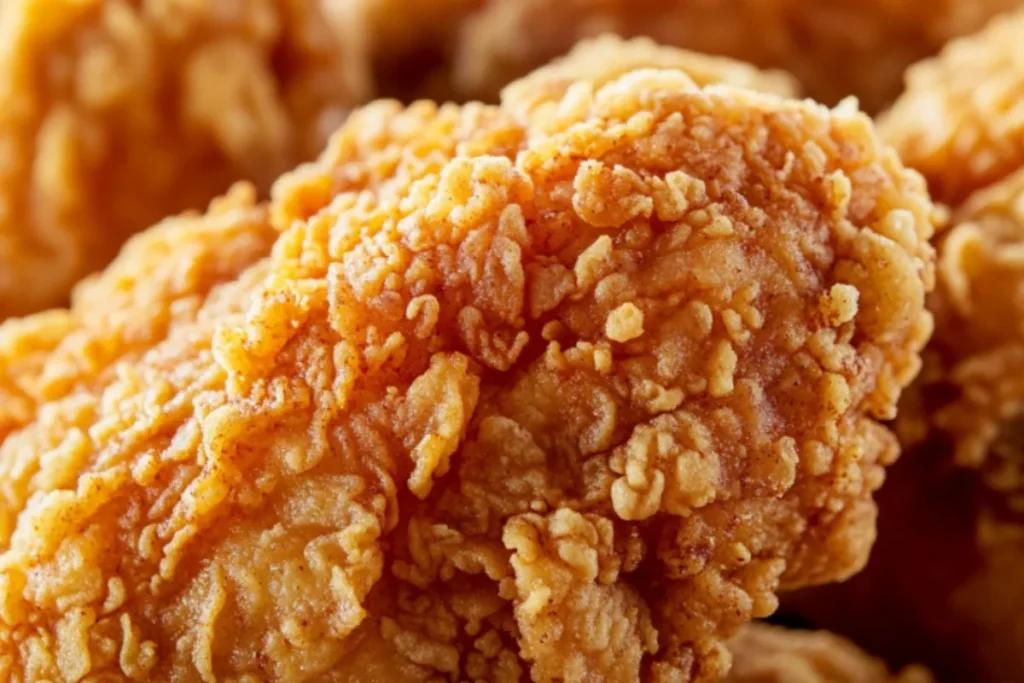
One of the tell-tale signs of great fried chicken is that perfect crispy skin. Here’s how to achieve it:
1. Double Breading vs. Single Breading
A single coat of flour will give you a decent crisp, but if you want that thick, crunchier crust, double breading is the way to go. After dipping the chicken in the buttermilk and flour, dip it again in the wet batter, then coat it with flour a second time. The double coat locks in moisture and makes the crust even crunchier.
2. Rest the Chicken
Once your chicken is fried to golden perfection, let it rest on a cooling rack for a few minutes. This allows excess oil to drip away, and it helps maintain the crispy texture. Resting the chicken also ensures the juices inside stay locked in, making every bite juicy and flavorful.
How to Avoid Common Mistakes
Even seasoned cooks can make mistakes when frying chicken. It’s easy to get caught up in the excitement of creating the perfect dish, but there are a few common pitfalls to avoid. Let’s take a look:
Preventing Oil Saturation in the Chicken
One of the most frustrating issues is ending up with oily, greasy chicken. To prevent this, make sure to avoid overcrowding the pan, as it reduces the oil temperature. Also, ensure you’re not leaving the chicken in the oil for too long. Overcooking it can result in a greasy mess instead of crispy perfection.
Troubleshooting Overcooked or Undercooked Chicken
Getting the cooking time just right is key to preventing overcooked or undercooked chicken. If your chicken is overcooked, it’ll be dry and tough. If it’s undercooked, you risk foodborne illness. Always use a meat thermometer to check for doneness. The internal temperature of the chicken should reach 165°F (74°C). If you’re unsure, let the chicken rest for a few minutes, then cut into the thickest part of the meat to check if the juices run clear.
Another trick to avoid overcooking your chicken is to let it rest for a few minutes after frying. This helps the juices redistribute within the meat and ensures that the chicken stays moist and tender.
Maintaining a balanced diet is crucial for overall health and well-being, and even indulging in fried chicken can be part of a healthy eating plan when enjoyed in moderation and paired with nutritious sides.
Conclusion: Frying Chicken Like a Pro
Frying chicken at home may seem like a daunting task at first, but with the right tools, ingredients, and techniques, it can be incredibly rewarding. The key is in the details—from seasoning the chicken to mastering the oil temperature, every step matters.
By following the tips and tricks shared in this guide, you can create fried chicken that’s crispy, juicy, and packed with flavor. Don’t forget to adjust the seasonings to suit your taste, and keep practicing your frying technique. With time, you’ll be frying up chicken like a true pro!
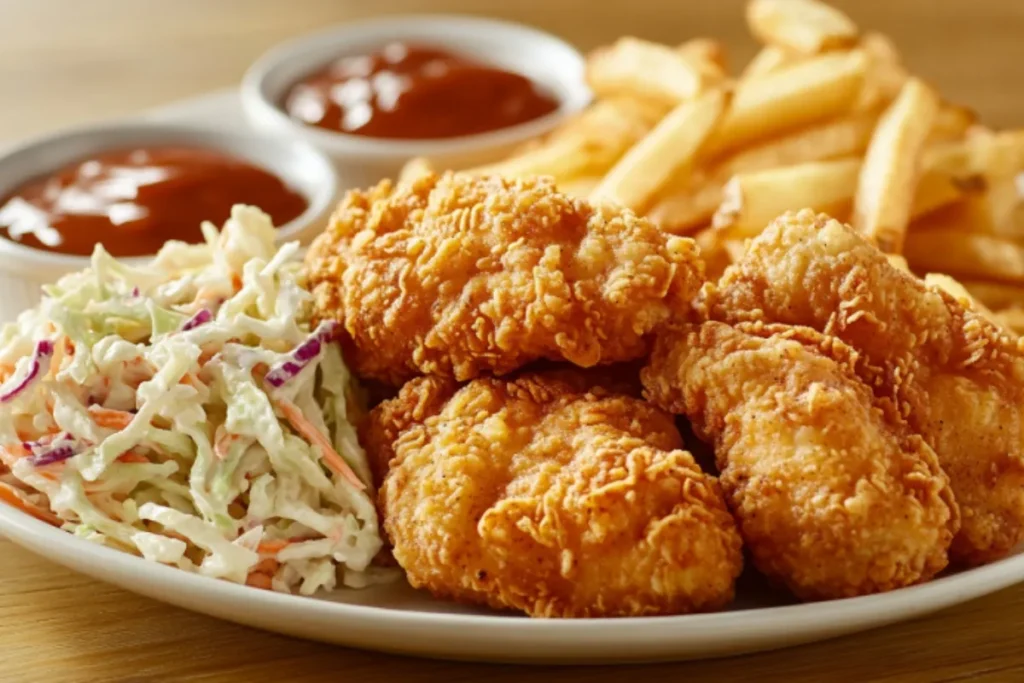
FAQs
After all the tips and techniques we’ve covered, you’re probably eager to try frying your own chicken. But sometimes, questions come up while you’re cooking, right? Don’t worry! We’ve got you covered with answers to some of the most common questions about frying chicken. Let’s dive in!
How to Make Fried Chicken in 5 Steps?
Making fried chicken in 5 simple steps is easier than you might think! Here’s how to do it:
- Marinate the Chicken: Start by marinating your chicken. This helps to tenderize the meat and infuse it with flavor. A buttermilk soak or a simple marinade with herbs and spices is a great way to go.
- Prepare the Coating: Next, coat your chicken with a mixture of flour, seasonings, and any extra spices you like. If you want a thicker, crunchier crust, go for the double breading technique.
- Heat the Oil: Make sure your oil is at the right temperature (around 350°F). Test it with a small piece of bread or a chicken scrap to ensure it’s ready.
- Fry the Chicken: Fry your chicken in batches, ensuring the oil doesn’t overcrowd. Cook until the chicken reaches an internal temperature of 165°F and the crust is golden brown.
- Let It Rest: Once the chicken is done, rest it on a wire rack or paper towels to let any excess oil drip off.
How to Fry Chicken in 3 Steps?
Frying chicken doesn’t need to be complicated. Here’s a simpler method for beginners in just three steps:
- Coat the Chicken: Coat your chicken pieces with seasoned flour or a batter. Don’t forget to add your spices for extra flavor!
- Fry the Chicken: Heat your oil to 350°F, then gently place the chicken in the hot oil. Let it cook for about 10-12 minutes, turning occasionally.
- Rest the Chicken: Remove the chicken from the oil and let it sit for a few minutes. This ensures the juices stay inside, making your fried chicken moist and tender.
Do You Dip the Chicken in Egg or Flour First?
It’s generally better to dip the chicken in flour after coating it in egg or a buttermilk soak. Here’s the reasoning: The egg or buttermilk helps the flour stick better, forming that delicious, crispy coating. So, the sequence is:
- Dip the chicken in the wet mixture (buttermilk or egg).
- Then, coat it in the seasoned flour or batter.
This method ensures the crust adheres nicely and stays intact during frying.
Why Is Oil Temperature Important for Frying Chicken?
Oil temperature is crucial when frying chicken. If the oil is too hot, your chicken might burn on the outside before cooking through. On the flip side, if the oil is too cold, the chicken will absorb more oil, becoming greasy instead of crispy.
The ideal frying temperature is about 350°F. It’s best to use a thermometer to monitor the oil and ensure the chicken fries evenly. When you get the temperature right, you’ll achieve that golden-brown, crispy skin every time.
How Can I Keep Fried Chicken Crispy After Frying?
Keeping fried chicken crispy after frying can be a challenge, but it’s not impossible! Here are a few tips to maintain that crunch:
- Rest on a Cooling Rack: Instead of placing your chicken directly on a plate, use a cooling rack. This allows air to circulate around the chicken, preventing it from becoming soggy from trapped steam.
- Avoid Covering the Chicken: Covering the chicken can trap moisture and make the crust soggy. So, let it rest uncovered.
- Serve Immediately: For the best texture, serve the fried chicken right after it rests. The longer it sits, the more likely it is to lose that crispy crunch.
Can I Use a Different Oil for Frying Chicken?
Yes, you can! While vegetable oil and peanut oil are typically recommended for frying chicken due to their high smoke points, you can also use oils like sunflower, canola, or even avocado oil.
However, remember that different oils might impart subtle flavor differences. For instance, peanut oil adds a slightly nutty taste, while avocado oil is a bit milder. So, feel free to experiment with different oils to find the one you love best.
How Long Should I Fry Chicken?
The frying time can vary depending on the size of your chicken pieces. Generally, you should fry chicken for about 10-12 minutes for smaller pieces (like wings or drumsticks) and around 15-20 minutes for larger pieces (like breasts or thighs).
Make sure the internal temperature reaches 165°F to ensure the chicken is fully cooked. The outside should be golden brown and crispy, while the inside stays tender and juicy.

